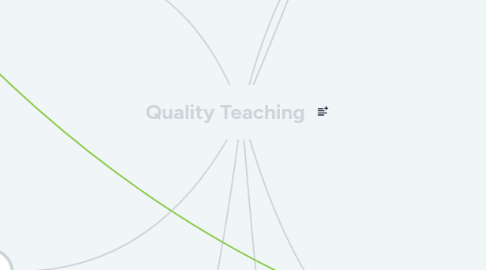
1. Quality Teaching: It's Intentional
1.1. Teacher Beliefs, knowledge, and skills are crucial
1.2. All students reach full potential
1.3. Search for ways to meet student needs
1.4. Classroom Environment: - Flexible Groupings - Accountable talk - Student leadership - Teacher conferencing
2. Critical Literacy
2.1. Is an attitude (being critical / constructive) rather than a method
2.2. There are conflicting sources which need to be evaluated for truth, trustworthiness, bias
2.3. The issue can involve ideology, politics
2.4. Requires understanding how text works through multiple lenses to understand the position and manipulative capability
2.5. How do images factor in?
2.6. How do you debate between different views?
2.7. Representation as re-presentation
2.7.1. How is the information presented? Who is it presented by?
3. Adaptive Teaching
3.1. Different approach = different results
3.2. Some material needs rote teaching, other subjects can use inquiry approach
3.3. Situation will dictate which approach the classroom teacher uses to present the material
3.4. Rote teaching better for tying shoes and multiplication tables
3.5. Inquiry based learning used where there are deep questions and multiple answers available
3.5.1. Rote / focused learning still needed as teacher notices gaps in learning
4. Ongoing Assessment
4.1. Conference regularly with students
4.1.1. Give immediate feedback on their learning
4.2. Instructional decisions can be made in a timely way
4.3. Good questioning shows student understanding of material
4.4. Co-created assessment (e.g. rubrics) give students expectations and teachers a guide of what needs explicit teaching
4.5. Running records allow you to see where students are tripping up
4.5.1. Opportunity for mini-lesson / word work
4.6. Possibility of professional learning - group assessment of a task
4.6.1. Different perspectives
4.7. Share feedback you have with child
5. Teaching for the 21st Century
5.1. Use of inquiry teaching - give an area of interest and allow students to explore the material in a way interesting to them
5.2. Information gathered from multiple sources, both online and physical texts
5.3. Learning snowballs - one answer generates another question to investigate
5.4. Students share their learning / interest with others - each student would be exploring a slightly different area
5.5. Students are able to be curious
5.6. Teacher role is to prompt, add / clarify the details, guide discussion, summarize
6. Resource Selection
6.1. Goal is to engage students, address curriculum, is current, reliable, and relatable
6.2. Provide a choice for students to explore
6.3. Change up resources based on learning focus and student ability
6.4. Increase vocabulary
6.4.1. If understanding of material is shallow, comprehension suffers
6.4.2. Word wall - define word then go beyond - investigate similarities and differences between it and other words
6.4.3. What types of words are being used?
6.4.3.1. Bias?
6.4.3.2. Hook?
6.4.4. Improves student writing
6.5. Meaningful use of technology
6.5.1. Use as a learning tool - blogs, email, answering questions, etc.
6.5.2. Creativity possibility - make music, programming, drawing, etc.
6.6. Use of local materials such as community newspapers
6.6.1. Access to current events
6.6.2. Local advertisements - what is important to people in the area?
6.6.3. Real world examples
